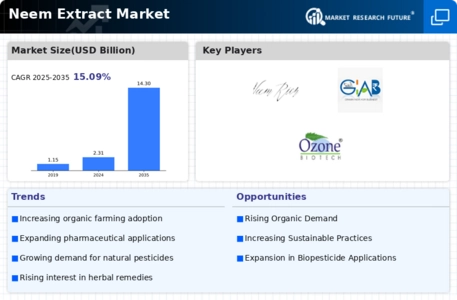Market Trends
Key Emerging Trends in the Neem Extracts Market
The demand for neem extracts is on the rise due to the numerous health benefits associated with their use in treating a variety of diseases, ranging from infectious and metabolic conditions to cancer. In April 2023, the Memorial Sloan Kettering Cancer Center in the United States revealed research findings indicating that neem extract exhibits anticancer properties, effectively inhibiting the growth of cancer cells. This breakthrough underscores the potential of neem extract as a valuable resource in the fight against cancer. Neem extracts are derived from various parts of the neem tree, including the leaves, bark, flowers, fruits, twigs, gum, and seeds. The comprehensive utilization of all these components contributes to the multifaceted properties of neem extracts. The table below illustrates the diverse uses of different parts of the neem tree in extract form for treating various diseases. As evidenced by various studies, the diverse properties inherent in neem extracts, as showcased in the table, contribute to their efficacy in treating a spectrum of diseases. This versatility and broad applicability of neem extracts have resulted in an escalating demand, propelling the growth of the neem extract market. The neem tree, scientifically known as Azadirachta indica, has long been recognized for its medicinal properties in traditional medicine systems. The increasing interest and validation of neem extract benefits by modern research institutions, such as the Memorial Sloan Kettering Cancer Center, further contribute to the growing demand for neem extracts in the healthcare sector. The antiviral, anti-inflammatory, antifungal, and antioxidant properties found in neem extracts make them invaluable in the treatment of infectious diseases, inflammatory conditions, fungal infections, and as an antioxidant therapy. Additionally, neem extracts derived from different parts of the tree address specific health concerns, showcasing the adaptability of neem in diverse medical applications. In conclusion, the surging demand for neem extracts is intricately linked to their proven efficacy in the treatment of a wide array of diseases. The ongoing research and recognition of neem's therapeutic potential, particularly in cancer treatment, underscore its significance in modern healthcare. As consumers increasingly seek natural and holistic remedies, the market for neem extracts is expected to continue its upward trajectory, offering a natural and versatile solution for various health challenges.









Leave a Comment